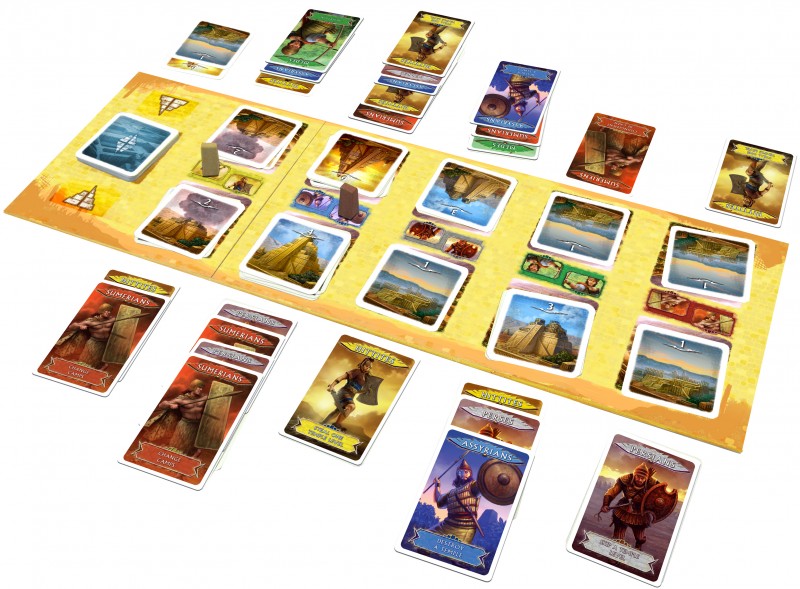In the days of yore, monarchs used to construct huge temples to demonstrate their great power and wealth. I suppose the phrase: “it’s not the size that matters…” hadn’t been coined yet. In this two player game, you’ll be tasked with being the one who constructs the most majestic and imposing temples…though you’ll be able to play cards to further your own goals whilst messing up whatever plans your opponent may have. Let’s get right down to building, shall we?
Components
The game includes 1 Game Board, 45 Temple Cards (valued 1-6), 60 Nation Cards (12 of each of the 5 nations), and 2 Pawns.
Setup & Gameplay
The board is placed between the players with each player receiving one temple card valued at “1” (Note: This temple card MUST be constructed on a player’s first turn). The rest of the temple cards are shuffled and placed face-down on the appropriate board space. Each player gets a pawn and places it on their quarry space. The nation cards are shuffled and each player gets a starting hand of 3 (starting player) / 5 (second player) cards. The rest form a face-down draw pile near the board.
On a player’s turn, they’ll:
1. Draw three nation cards.
2. Perform as many actions as they’d like. These include:
- a) Move their building pawn – discard a nation card to move their pawn to the matching construction site.
- b) Deploy a nation card – play a card below the construction site in which your pawn resides. The cards overlap in such a manner to where they can still be seen (like in “Solitaire”).
- c) Construct a temple – take a temple from either stack and place it on the construction site in which your pawn resides. The player must have a number of nation cards present equal to or greater than the temple card’s value.
- d) Perform a migration (no more than once per turn) – move three cards (no more, no less) from one site to another no matter where your pawn resides.
- e) Use a nation’s special ability – discard one card in a set of three consecutive, same colored cards to perform its special ability. The pawn must be present at the site in order to make use of this action. Instead of using the card’s ability, the player may make use of a standard ability which forces their opponent to discard half of their cards.
3. Draw two temple cards and place them in ascending order on the temple stack closest to them. The player will not re-order the cards already in the pile, only the two just drawn.
The game ends when the combined value of someone’s row of temples is “15” or greater AND the combined value of their opponent’s row of temples is “9” or less (the former player wins). In the event someone reaches “15” but the other player is above “9”, the game will enter the “end phase”. Players continue playing until someone reaches “20” or more OR “9” or less, in which case the game immediately ends. The game also ends when the deck of temple cards runs out, in which case the winner is the player with the most temple points.
Editor’s Note: The above doesn’t cover all of the rules found in the manual, but should give you an idea as to how the game is played.
The Review
“Babel” is a pretty fun game, albeit an aggressive one. A lot of the card abilities revolve around messing with your opponent in some way, shape, or form. This can turn a few people off, especially those who take things personally when playing games. In other words, things can go downhill very quickly if you’re playing against a sore loser. With that said, I suppose you could try playing without the aggressive actions and just focus on building temples…though you’d be missing out on some of the strategies that the special abilities bring forth. Still, a passive variant/rule set is still viable and worth exploring, I feel.
Speaking of strategy, the game has plenty to offer in that regard. A lot of the standard actions one can take stipulate that you must have your pawn at that location in order to perform them at all. Since you have to discard a card to move the pawn, you’ll often be wondering what colors to lay down in sets (a set of three or more allows you to use the card color’s ability) and what cards to discard for the sake of moving the pawn. Each card color has a unique ability, further complicating your best-laid plans. It’s best to not get too attached to any one plan though, as your opponent can easily play the required cards needed to use an ability and mess everything up on a whim.
While everything was colorful and thematic, the cards tended to bend easily while shuffling. The board itself and the rest of the components are fine, I just think that the card quality could have been slightly better than it was for a $20 game (as of 9/9/15). The rules are quite simple despite the forty-five minute play time, so it’s easy to recommend to casual players not looking for a hardcore experience. Again, this game is best played with someone you can joke around and have a good time with as it can get pretty “in-your-face-ish”. If finding people like this isn’t possible, then I think less aggressive card games like “Lost Cities” might be a better fit.
Final Verdict: 7/10
—


